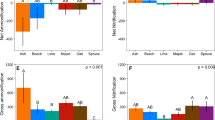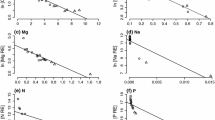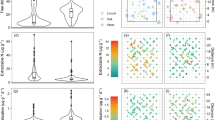Abstract
Forest biogeochemical cycles are shaped by effects of dominant tree species on soils, but the underlying mechanisms are not well understood. We investigated effects of temperate tree species on interactions among carbon (C), nitrogen (N), and acidity in mineral soils from an experiment with replicated monocultures of 14 tree species. To identify how trees affected these soil properties, we evaluated correlations among species-level characteristics (e.g. nutrient concentrations in leaf litter, wood, and roots), stand-level properties (e.g. nutrient fluxes through leaf litterfall, nutrient pools in stemwood), and components of soil C, N, and cation cycles. Total extractable acidity (aciditytot) was correlated positively with mineral soil C stocks (R 2 = 0.72, P < 0.001), such that a nearly two-fold increase in aciditytot was associated with a more than two-fold increase of organic C. We attribute this correlation to effects of tree species on soil acidification and subsequent mineral weathering reactions, which make hydrolyzing cations available for stabilization of soil organic matter. The effects of tree species on soil acidity were better understood by measuring multiple components of soil acidity, including pH, the abundance of hydrolyzing cations in soil solutions and on cation exchange sites, and aciditytot. Soil pH and aciditytot were correlated with proton-producing components of the soil N cycle (e.g. nitrification), which were positively correlated with species-level variability in fine root N concentrations. Soluble components of soil acidity, such as aluminum in saturated paste extracts, were more strongly related to plant traits associated with calcium cycling, including leaf and root calcium concentrations. Our results suggest conceptual models of plant impacts on soil biogeochemistry should be revised to account for underappreciated plant traits and biogeochemical processes.




Similar content being viewed by others
References
Alriksson A, Eriksson HM (1998) Variations in mineral nutrient and C distribution in the soil and vegetation compartments of five temperate tree species in NE Sweden. For Ecol Manag 108(3):261–273
Amacher MC, Henderson RE, Breithaupt MD, Seale CL, LaBauve JM (1990) Unbuffered and buffered salt methods for exchangeable cations and effective cation-exchange capacity. Soil Sci Soc Am J 54(4):1036–1042
Augusto L, Ranger J, Binkley D, Rothe A (2002) Impact of several common tree species of European temperate forests on soil fertility. Ann For Sci 59(3):233–253
Binkley D (1995) The influence of tree species on forest soils: processes and patterns. In: Mead DJ, Cornforth IS (eds) Proceedings of the Trees and Soils Workshop. Agronomy Society of New Zealand
Binkley D, Giardina C (1998) Why do tree species affect soils? The warp and woof of tree-soil interactions. Biogeochemistry 42(1–2):89–106
Binkley D, Richter D (1987) Nutrient cycles and H+ budgets of forest ecosystems. Adv Ecol Res 16:1–51
Binkley D, Valentine D (1991) 50-year biogeochemical effects of green ash, white pine, and Norway spruce in a replicated experiment. For Ecol Manag 40(1–2):13–25
Campbell JL, Rustad LE, Boyer EW, Christopher SF, Driscoll CT, Fernandez IJ, Groffman PM, Houle D, Kiekbusch J, Magill AH, Mitchell MJ, Ollinger SV (2009) Consequences of climate change for biogeochemical cycling in forests of northeastern North America. Can J For Res 39(2):264–284
Chadwick OA, Chorover J (2001) The chemistry of pedogenic thresholds. Geoderma 100:321–353
Chorover J, Kretzschmar R, Garcia-Pichel F, Sparks DL (2007) Soil biogeochemical processes within the critical zone. Elements 3(5):321–326
Dauer JM, Chorover J, Chadwick OA, Oleksyn J, Tjoelker MG, Hobbie SE, Reich PB, Eissenstat DM (2007) Controls over leaf and litter calcium concentrations among temperate trees. Biogeochemistry 86(2):175–187
De Schrijver A, Geudens G, Augusto L, Staelens J, Mertens J, Wuyts K, Gielis L, Verheyen K (2007) The effect of forest type on throughfall deposition and seepage flux: a review. Oecologia 153(3):663–674
De Schrijver A, De Frenne P, Staelens J, Verstraeten G, Muys B, Vesterdal L, Wuyts K, Van Nevel L, Schelfhout S, De Neve S, Verheyen K (2011) Tree species cause divergence in soil acidification during four decades of post-agricultural forest development. Global Change Biol. doi:10.1111/j.1365-2486.2011.02572.x
Dijkstra FA, Fitzhugh RD (2003) Aluminum solubility and mobility in relation to organic carbon in surface soils affected by six tree species of the northeastern United States. Geoderma 114(1–2):33–47
Ellison AM, Bank MS, Clinton BD, Colburn EA, Elliott K, Ford CR, Foster DR, Kloeppel BD, Knoepp JD, Lovett GM, Mohan J, Orwig DA, Rodenhouse NL, Sobczak WV, Stinson KA, Stone JK, Swan CM, Thompson J, Von Holle B, Webster JR (2005) Loss of foundation species: consequences for the structure and dynamics of forested ecosystems. Front Ecol Environ 3(9):479–486
Fierer N, Strickland MS, Liptzin D, Bradford MA, Cleveland CC (2009) Global patterns in belowground communities. Ecol Lett 12(11):1238–1249
Finzi AC, Canham CD, Van Breemen N (1998a) Canopy tree soil interactions within temperate forests: species effects on pH and cations. Ecol Appl 8(2):447–454
Finzi AC, Van Breemen N, Canham CD (1998b) Canopy tree soil interactions within temperate forests: species effects on soil carbon and nitrogen. Ecol Appl 8(2):440–446
Fujii K, Funakawa S, Hayakawa C, Kosaki T (2008) Contribution of different proton sources to pedogenetic soil acidification in forested ecosystems in Japan. Geoderma 144(3–4):478–490
Gundersen P, Rasmussen L (1990) Nitrification in forest soils—effects from nitrogen deposition on soil acidification and aluminum release. Rev Environ Contam Toxicol 113:1–45
Hagen-Thorn A, Callesen I, Armolaitis K, Nihlgard B (2004) The impact of six European tree species on the chemistry of mineral topsoil in forest plantations on former agricultural land. For Ecol Manag 195(3):373–384
Hobbie SE, Reich PB, Oleksyn J, Ogdahl M, Zytkowiak R, Hale C, Karolewski P (2006) Tree species effects on decomposition and forest floor dynamics in a common garden. Ecology 87(9):2288–2297
Hobbie SE, Ogdahl M, Chorover J, Chadwick OA, Oleksyn J, Zytkowiak R, Reich PB (2007) Tree species effects on soil organic matter dynamics: the role of soil cation composition. Ecosystems 10(6):999–1018
Hobbie SE, Oleksyn J, Eissenstat DM, Reich PB (2010) Fine root decomposition rates do not mirror those of leaf litter among temperate tree species. Oecologia 162(2):505–513
Jegou D, Cluzeau D, Hallaire V, Balesdent J, Trehen P (2000) Burrowing activity of the earthworms Lumbricus terrestris and Aporrectodea giardi and consequences on C transfers in soil. Eur J Soil Biol 36(1):27–34
Manzoni S, Porporato A (2009) Soil carbon and nitrogen mineralization: theory and models across scales. Soil Biol Biochem 41(7):1355–1379
Mareschal L, Bonnaud P, Turpault MP, Ranger J (2010) Impact of common European tree species on the chemical and physicochemical properties of fine earth: an unusual pattern. Eur J Soil Sci 61(1):14–23
Menyailo OV, Hungate BA, Zech W (2002a) The effect of single tree species on soil microbial activities related to C and N cycling in the Siberian artificial afforestation experiment—Tree species and soil microbial activities. Plant Soil 242(2):183–196
Menyailo OV, Hungate BA, Zech W (2002b) Tree species mediated soil chemical changes in a Siberian artificial afforestation experiment—Tree species and soil chemistry. Plant Soil 242(2):171–182
Mikutta R, Zang U, Chorover J, Haumaier L, Kalbitz K (2011) Stabilization of extracellular polymeric substances (Bacillus subtilis) by adsorption to and coprecipitation with Al forms. Geochim Cosmochim Acta 75:3135–3154
Moukoumi J, Munier-Lamy C, Berthelin J, Ranger J (2006) Effect of tree species substitution on organic matter biodegradability and mineral nutrient availability in a temperate topsoil. Ann For Sci 63(7):763–771
Muukkonen P (2007) Generalized allometric volume and biomass equations for some tree species in Europe. Eur J For Res 126(2):157–166
Parton W, Silver WL, Burke IC, Grassens L, Harmon ME, Currie WS, King JY, Adair EC, Brandt LA, Hart SC, Fasth B (2007) Global-scale similarities in nitrogen release patterns during long-term decomposition. Science 315(5810):361–364
Prescott CE (2005) Do rates of litter decomposition tell us anything we really need to know? For Ecol Manag 220(1–3):66–74
Priha O, Smolander A (1999) Nitrogen transformations in soil under Pinus sylvestris, Picea abies and Betula pendula at two forest sites. Soil Biol Biochem 31(7):965–977
Reich PB, Oleksyn J, Modrzynski J, Mrozinski P, Hobbie SE, Eissenstat DM, Chorover J, Chadwick OA, Hale CM, Tjoelker MG (2005) Linking litter calcium, earthworms and soil properties: a common garden test with 14 tree species. Ecol Lett 8(8):811–818
Ross DS, Matschonat G, Skyllberg U (2008) Cation exchange in forest soils: the need for a new perspective. Eur J Soil Sci 59(6):1141–1159
Scheel T, Jansen B, van Wijk AJ, Verstraten JM, Kalbitz K (2008) Stabilization of dissolved organic matter by aluminium: a toxic effect or stabilization through precipitation? Eur J Soil Sci 59(6):1122–1132
Sinsabaugh RL, Lauber CL, Weintraub MN, Ahmed B, Allison SD, Crenshaw C, Contosta AR, Cusack D, Frey S, Gallo ME, Gartner TB, Hobbie SE, Holland K, Keeler BL, Powers JS, Stursova M, Takacs-Vesbach C, Waldrop MP, Wallenstein MD, Zak DR, Zeglin LH (2008) Stoichiometry of soil enzyme activity at global scale. Ecol Lett 11(11):1252–1264
Staff SSL (2004) Soil survey laboratory methods manual. In: Burt R (ed) Soil survey investigations report. Lincoln, NE
Ter-Mikaelian MT, Korzukhin MD (1997) Biomass equations for sixty-five North American tree species. For Ecol Manag 97(1):1–24
van Breemen N, Mulder J, Driscoll CT (1983) Acidification and alkalinization of soils. Plant Soil 75(3):283–308
Vesterdal L, Schmidt IK, Callesen I, Nilsson LO, Gundersen P (2008) Carbon and nitrogen in forest floor and mineral soil under six common European tree species. For Ecol Manag 255(1):35–48
von Lutzow M, Kogel-Knabner I, Ekschmitt K, Matzner E, Guggenberger G, Marschner B, Flessa H (2006) Stabilization of organic matter in temperate soils: mechanisms and their relevance under different soil conditions—a review. Eur J Soil Sci 57(4):426–445
Wardle DA, Bardgett RD, Klironomos JN, Setälä H, van der Putten WH, Wall DH (2004) Ecological linkages between aboveground and belowground biota. Science 304(5677):1629–1633
Withington JM, Reich PB, Oleksyn J, Eissenstat DM (2006) Comparisons of structure and life span in roots and leaves among temperate trees. Ecol Monogr 76(3):381–397
Zianis D, Muukkonen P, Mäkipää R, Mencuccini M (2005) Biomass and stem volume equations for tree species in Europe. Silva Fennica Monogr 4:1–63
Acknowledgments
We thank Burt Thomas, Katherine Freeman, Jörg Prietzl, Michael Castellano, and Jason Kaye for helpful discussion. DME and KEM acknowledge National Science Foundation (NSF) awards DEB-0816935 and OISE-0754731. OAC, JC, DME, SEH, JO, and PBR were also supported by NSF DEB-0128958. KEM received a US Department of Energy Graduate Research Environmental Fellowship and a European Association of Organic Geochemists travel award.
Author information
Authors and Affiliations
Corresponding author
Electronic supplementary material
Below is the link to the electronic supplementary material.
Rights and permissions
About this article
Cite this article
Mueller, K.E., Eissenstat, D.M., Hobbie, S.E. et al. Tree species effects on coupled cycles of carbon, nitrogen, and acidity in mineral soils at a common garden experiment. Biogeochemistry 111, 601–614 (2012). https://doi.org/10.1007/s10533-011-9695-7
Received:
Accepted:
Published:
Issue Date:
DOI: https://doi.org/10.1007/s10533-011-9695-7




